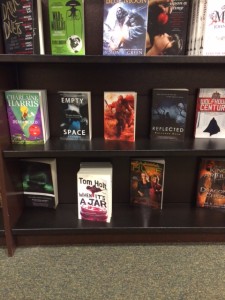A trait is a distinguishing characteristic or quality, especially of one’s personal nature, defined by Dictionary.com. When using traits with a paranormal twist you can go with classic takes, such as mind to mind communication that Bram Stoker uses in Dracula and, one of the most common vampire traits, the elongated fangs. Stoker takes Dracula’s desire to speak to Mina enhancing it into a physical experience in mind and body transcending all logic, creating intimacy where there was none.
Taking things a step further, let’s look at the Argeneau Series by Lynsay Sands. The mind to mind communication in Sands vampires (Immortals as she calls them) becomes sexually charged as the heroes and heroines learn they are life mates. They share each other’s pleasure to a point their intimacy boils to such a peak they pass out, anywhere. She’s created a situation where she uses all the five senses, smell, sight, sound, taste, and touch. However, what happens goes beyond the physical and becomes a sharing between the two characters on a mental level. With humans, to the extent she explains, this would not be possible in real life. This adds something to her vampires that no one had ever seen yet in the genre.
Conflict develops when the no-fangers, vampires without fangs come on the scene. Let’s just say, they’re a tad bit crazy. To make it even more fun she adds a third type without fangs called edentates, another generation not touched by the crazies. She goes into detail about the three distinctions adding history to the series and to her characters. These are some of the steamiest, funniest, and scariest scenes I’ve ever read. Lynsay Sands uses the physical trait to drive the plot arc in several of her books, motivating good and evil in a race to meet their goals.
My favorite character trait is smell. With most predators, smell is a basic tool in their repertoire. J.R. Ward uses the trait brilliantly in the Black Dagger Brotherhood series. Introduced first in Dark Lover, Wrath and Beth meet, and at first, Wrath is lead to her by duty. However, when he gets near her, her scent is so intoxicating he has to have her. Eventually Beth can’t resist him either. His scent is headier than a spicy merlot laden with pheromones. He’s like a drug and she’s drawn to him in every way. As intimacy grows, the musky scent cloaks the chosen mate of the vampire, warning any other males or females to back off. With this one trait, J.R. Ward creates some sexy heart pounding moments in and out of the bedroom.
Werewolves, another classic paranormal creature, can also compel readers with the use of unique traits. For example, take a snap shot of the wolf in its normal habitat and find traits that translate into the human hero or heroine. Nalini Singh does this in her Psy/Changeling series. Ask yourself, how does a male wolf act/react to a female wolf? Outside forces threaten the female, how would the alpha wolf handle the threat? Immerse yourself in the five senses of a wolf. What would he do around a female to show his interest? Would he rub, lick, or bite the female to mark her with his scent? Even the words rub, lick, and bite spice up a scene, heating up the romance between human characters. How would it enhance a paranormal romance? Would he use sound, his howl to attract a female or scare away an enemy, let someone know he was hurt? How do these questions translate from wolf to human characters? Does the alpha male fight other males to stake his claim of the female? Is the human hearing extra sensitive alongside sight, smell, taste, and touch?
My examples above of vampires and werewolves are not the only human traits to translate into paranormal characters; the two are just more widely recognized. You decide what traits work best for your characters helping create intensity, intimacy, and excitement that ramp up your plot, compelling readers to turn pages. Use the five senses and physical traits to open doors in your mind. But be careful. The traits you decide on have to have purpose that drive the story forward, twisting the normal into paranormal.
Happy Writing!


